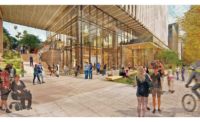For the TELUS data center, the design-build contractor agreed to cover any utility-bill extras if the building does not perform as promised.
The jury is still out on the performance of the 209,000-sq-ft ">Federal Center South office building because it opened only last month. The U.S. General Services Administration required the performance-based design-build team to be at risk for 0.5% of its original contract based on whether energy-use targets are met.
Lack of data on performance of LEED-certified buildings is becoming another hot topic. USGBC is trying to meet calls for post-occupancy information through a free search engine, launched this fall, called ">The Green Building Information Gateway.
Digital databases and other forms of technology also are giving research a stronger backbone. This year, the California Strong Motion Instrumentation Program installed the nation’s densest array of ">accelerometers in the 641-ft-tall One Rincon Hill’s South Tower in San Francisco. The idea is to record valuable data, at a remote location, about the tower’s performance when the expected Big One hits the Bay Area.
Building teams and owners have been in search of the Holy Grail of project delivery for many years. This year, the first hospital constructed using integrated project delivery with an 11-party, risk-and-reward contract was completed six weeks early and without claims. However, there was no money left in the contingency fund to share at the end of the project.
Another collaborative project, which relied on digital tools, opened on Sept. 28. Brooklyn's controversial ">Barclays Center Arena required more than the usual dose of cooperation when, late in the game, the owner brought in a facade designer to put a completely new face on the arena.
And work finally got under way—several years late—on the ">New Santa Clara Stadium, built in California for the San Francisco 49ers of the National Football League. The team is the first sports franchise to use—from the get-go—a hybrid, collaborative project delivery model that combines the best features of many delivery systems, including integrated project delivery. Proof of concept, however, will have to wait until mid-2014, when the stadium is scheduled to open.
On the global stage, the contest to be the host city for the future “supertallest” building in the world is on the upswing, thanks to the start of construction of the planned 1-kilometer-plus ">Kingdom Tower in Riyadh, Saudi Arabia. The building, if completed, would easily outrank the current record holder: the 828-meter-tall Burj Khalifa in Dubai.
Back down to earth, on the East Coast and especially in Lower Manhattan, Superstorm Sandy triggered a debate over how to best make commercial ">buildings the last line of defense against flooding. That discussion is likely to last for several years.



Post a comment to this article
Report Abusive Comment